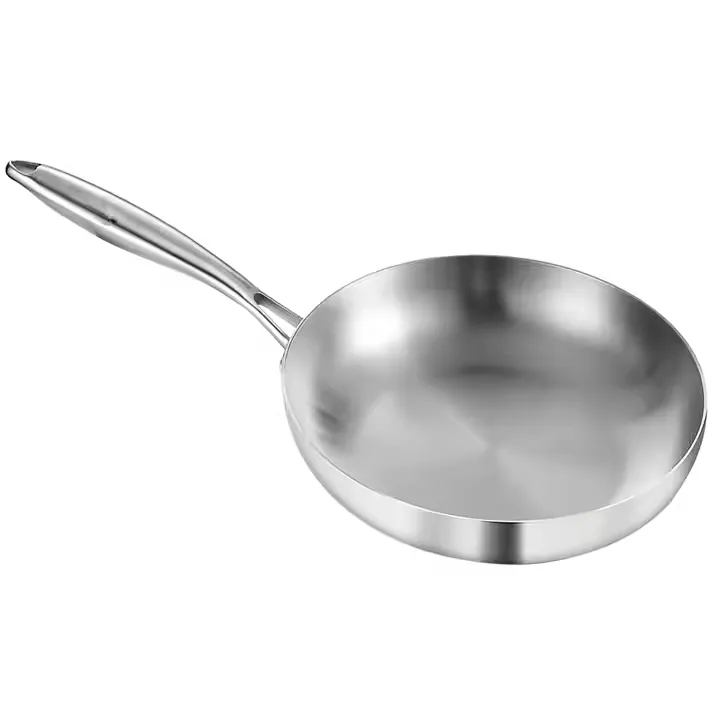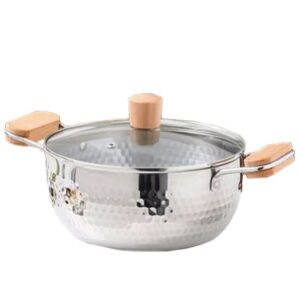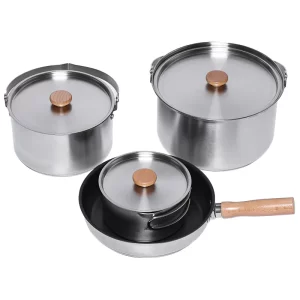في عالم المطبخ، يتعلق اختيار أواني الطهي المناسبة بأكثر من مجرد إعداد الطعام الجيد؛ بل يتعلق الأمر أيضًا بعيش حياة جيدة في المطبخ. عندما يتعلق الأمر بالاختيار بين أواني الطهي المصنوعة من الفولاذ المقاوم للصدأ مقابل أواني الطهي غير اللاصقة، عادةً ما يكون الأمر شخصيًا، ويتعلق بنوع الطهي الذي يرغب المرء في الانغماس فيه، والميزانية، والمخاوف الصحية أو البيئية. سوف تستكشف هذه المقالة بعمق خصائص كلتا المادتين وتقدم دليلاً شاملاً لمساعدتك على اتخاذ قرار مستنير بشأن أيهما يلبي احتياجاتك بشكل أفضل. أيًا كانت أواني الطهي التي تختارها, تشانسيسكوك قد غطت عليك!
المحتويات
تبديلما هي أواني الطهي المصنوعة من الفولاذ المقاوم للصدأ؟
تُصنع أواني الطهي المصنوعة من الفولاذ المقاوم للصدأ من سبيكة تقاوم التآكل، وعادة ما تتكون من الكروم والنيكل وعناصر أخرى توفر القوة ومقاومة الصدأ. إن متانتها ومقاومتها لدرجات الحرارة المرتفعة تجعل أواني الطهي المصنوعة من الفولاذ المقاوم للصدأ مثالية للطهاة المحترفين وعشاق الطهي المنزلي على حد سواء. لكن الفولاذ المقاوم للصدأ ليس معصومًا تمامًا، حيث يتطلب عناية خاصة للحفاظ على بريقه وقد لا يكون أسهل أنواع أواني الطهي في التنظيف. نظرًا لأن الفولاذ المقاوم للصدأ ليس موصلًا جيدًا للحرارة بشكل طبيعي، فإن بعض أواني الطهي الراقية المصنوعة من الفولاذ المقاوم للصدأ تحتوي على الألومنيوم أو النحاس في الساندويتش لتوصيل حراري أفضل.
أواني الطبخ من تشانسيسكوك، المصنوعة من الفولاذ المقاوم للصدأ تم تصنيعها من مواد عالية الجودة يمكن استخدامها للتشويح والقلي السريع والسلق والطبخ على نار هادئة والشوي والتحمير. يتحمّل الفولاذ المقاوم للصدأ درجات حرارة أعلى ويمكن استخدامه من الموقد إلى الفرن.
ما هي أواني الطهي المانعة للالتصاق؟
تُصنع أواني الطهي المانعة للالتصاق عن طريق وضع طبقة أو أكثر من طبقة أو أكثر من طلاء خاص، مثل التفلون، الذي يتميز بمعامل احتكاك منخفض للغاية يجعل الطعام أقل عرضة للالتصاق. تشمل مزايا استخدام أواني الطهي المانعة للالتصاق سهولة التنظيف وتقليل استخدام الشحوم وتقليب الأطعمة وتحميرها بشكل خفيف. ومع ذلك، فإن الطلاء لا يدوم إلى الأبد ويميل إلى التآكل أو التقشر مع مرور الوقت، مما يعني أن هناك حاجة إلى القليل من العناية لمنع استخدام الأواني المعدنية ودرجات الحرارة العالية التي قد تتلف الطلاء. المقالي غير اللاصقة ليست بالضرورة مقاومة للحرارة مثل المقالي المصنوعة من الفولاذ المقاوم للصدأ. فهي لا تصلح لدرجات الحرارة العالية وعادة ما تكون غير آمنة في الفرن.
سطح أواني الطبخ المانعة للالتصاق من تشانسيسكوك يتم معالجتها للحصول على طبقة نهائية متينة ومقاومة للتآكل. يمكن استخدامها لأي شيء يمكن أن يلتصق بالمقلاة، مثل الفطائر أو البيض أو التوفو المقلي أو السمك.
أواني الطهي المصنوعة من الفولاذ المقاوم للصدأ مقابل أواني الطهي غير اللاصقة: مقارنة الأداء
- التوصيل الحراري: لا تُعد أواني الطهي المصنوعة من الفولاذ المقاوم للصدأ أفضل موصل للحرارة، ولكن يمكن أن يعزز الهيكل المركب متعدد الطبقات من انتظام التسخين بشكل كبير، في حين تعتمد أواني الطهي غير اللاصقة على المعدن الأساسي لتوفير توزيع جيد للحرارة.
- المتانة: تعتبر أواني الطهي المصنوعة من الفولاذ المقاوم للصدأ متينة للغاية، في حين أن معظم الطلاءات المانعة للالتصاق تتلاشى بعد فترة من الزمن.
- الإفراج عن الطعام: تقوم أواني الطهي المانعة للالتصاق بعمل ممتاز، خاصة مع الأطعمة التي تلتصق مثل العجة أو السمك، بينما قد يتطلب الفولاذ المقاوم للصدأ المزيد من الزيت لمنع التصاق الطعام.
- سهولة التنظيف: من السهل جدًا تنظيف أواني الطهي غير اللاصقة نظرًا لخصائص سطحها، في حين أن أواني الطهي المصنوعة من الفولاذ المقاوم للصدأ، على الرغم من قوتها، تتطلب أحيانًا المزيد من الجهد لإزالة البقع العنيدة.
الاعتبارات البيئية والصحية
- سلامة المواد: تعتبر أواني الطهي المصنوعة من الفولاذ المقاوم للصدأ عالية الجودة آمنة ولا تنبعث منها مواد ضارة في الطعام، أما بالنسبة لأواني الطهي غير اللاصقة، فاختر المنتجات التي لا تحتوي على مواد كيميائية ضارة محتملة من مادة PFOA.
- التأثير البيئي: تُعتبر أواني الطهي المصنوعة من الفولاذ المقاوم للصدأ أكثر لطفاً بالبيئة لأنها تتمتع بعمر أطول، مما يقلل من معدل الاستبدال. في معظم الحالات، عندما ينكسر الطلاء على أواني الطهي غير اللاصقة، فهذا يعني أن على المرء استبدال أواني الطهي بأكملها، مما يساهم في إهدار الطعام.
تحليل التكاليف والفوائد
- تكلفة الشراء الأولية: بشكل عام، تعتبر أواني الطهي غير اللاصقة رخيصة نسبيًا، في حين أن أواني الطهي المصنوعة من الفولاذ المقاوم للصدأ عالية الجودة باهظة الثمن نسبيًا بسبب عملية تصنيعها المعقدة.
- اقتصاديات الاستخدام طويل الأجل: يمكن اعتبار أواني الطهي المصنوعة من الفولاذ المقاوم للصدأ أكثر اقتصاداً على المدى الطويل، حيث يتم الأخذ بعين الاعتبار المتانة وتكاليف الصيانة، خاصة إذا استمرت لسنوات أو حتى عقود.
كيفية اختيار أواني الطهي المناسبة لك
يعتمد اختيار أفضل أواني الطهي لنفسك على سلوكك في الطهي واحتياجات عائلتك الخاصة والمبلغ المالي الذي تريد استثماره. إذا كنتِ تقومين بالكثير من الطهي الثقيل بشكل متكرر وإذا كنتِ تضعين قيمة كبيرة على مدة بقاء أواني الطهي بالنسبة لكِ، فقد يكون الفولاذ المقاوم للصدأ هو الخيار الأفضل. أما إذا كنت ترغب في تقليل التنظيف واستخدام كمية أقل من الزيت، فإن أواني الطهي غير اللاصقة ستناسبك بشكل أفضل للاستخدام اليومي.
الخاتمة
بعد مراجعة الاختلافات الرئيسية بين أواني الطهي المصنوعة من الفولاذ المقاوم للصدأ وأواني الطهي غير اللاصقة، يمكننا أن نرى أن لكل منهما مزاياه الخاصة. يجب أن يعتمد القرار النهائي على الاحتياجات والتوقعات الفعلية للفرد. أيًا كان نوع أواني الطهي التي تختارها، تأكد من صيانتها بشكل صحيح وفقًا لتعليمات المنتج للحصول على الأداء الأمثل وطول العمر الافتراضي الأقصى.
كشركة مصنعة لأواني الطبخ وأدوات المطبخ المصنوعة من الفولاذ المقاوم للصدأ، تخلق Chances قيمة لعملائها في جميع أنحاء العالم من خلال الابتكار والجودة، حيث تقدم مجموعة شاملة من المنتجات الجاهزة بالإضافة إلى خدمات التخصيص لتلبية احتياجاتك. فرص أواني المطبخ بالجملة في مجموعة واسعة من أواني الطهي المتينة والمتعددة الاستخدامات غير اللاصقة والأواني والمقالي وأطقم الطهي المصنوعة من الفولاذ المقاوم للصدأ.









